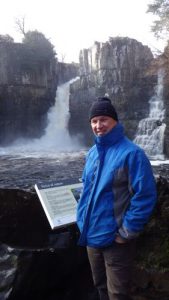During the EGU Election Autumn 2017, all EGU members are asked to give their vote for the next EGU Union President, General Secretary and the Division Presidents until 30 November 2017. The Geomorphology division is in the luxurious situation of having three candidates for division presidency, all of which gathered experience as active members of the EGU GM division structure.
In order to get to know the candidates a little better, the early career representatives of the GM division (Annegret Larsen and Micha Dietze) have asked the candidates a few questions from a ECS perspective. Below, we post the answers given by candidate #2, Jens Turowski.
Name: Jens Martin Turowski
Webpage: http://www.gfz-potsdam.de/en/section/geomorphology/staff/profil/jens-turowski/
Twitter: @JMTurowski
ECS: What is your field of research (three points maximum)
Jens Turowski: I strive to develop and improve conceptual and mathematical models of physical processes acting at the Earth’s surface using high-quality field data. My previous research has focused on mountain channels (bedload transport, fluvial bedrock erosion, channel morphology, role of organic matter), but I have been / I am also working on debris flows, rockfall-dominated landscapes and rocky coastlines. One of my special interest is the development and improvement of field techniques.
Why do you want to run for president?
One of the great things about geomorphology is that it is highly interdisciplinary. The division president has the privilege to directly liaise with the many divisions that thematically overlap with GM. I hope that I can build stronger ties to other disciplines that benefit both the geomorphology community and other disciplines.
What is the first thing you will change once elected president?
I believe that many of the services that the GM division currently offers run quite well and do not need major changes. I would like to improve the division web site to make it a better (-used) resource for the community and there are aspects of the OSPP competition that I am not happy about. Big challenges for the division lie in the connections to other scientific organizations that also represent geomorphology and with other divisions within EGU.
What is your view on the role of early career scientists within the EGU GM division?
Scientific organizations like the EGU often provide the first opportunities for young scientist to obtain leadership experience. Organizing sessions for the EGU General Assembly was my first step to getting involved in community service and into building a professional network beyond my immediate collaborators. I believe that both the GM division will profit from the involvement of young scientists and vice versa. I hope that I can include many young scientists in the GM program committee over the next few years.
I also see the EGU, and in particular the GM division, as a means to provide support to young scientists, for example by providing training opportunities. The EGU supports young scientist’s workshops and training schools that have benefitted me and hopefully many others. The OSPP poster competition is a valuable tool to highlight excellent research and help talented young scientists at the start of their career.
Last but not least: a network of peers in a similar situation, both professionally and personally, can help through difficult situations during a doctorate or post-doctoral studies and can open opportunities for research.
How will you safeguard diversity and inclusiveness within the EGU GM division?
Diversity and inclusiveness become more and more important, both within science and outside. I believe the GM division or the EGU as a whole can take action in two main areas: 1) providing a secure environment for research and communication, and 2) highlighting role models. I can think of several actions for point 1). For example, I would like to explore a kind of secure app with the EGU – if someone is in a threatening situation or faces harassment, let’s say during a poster discussion, support can be called via an app and a dedicated person comes along to help to diffuse the situation. Concerning role models, in the past we have for example strived to solicit female speakers in the ‘Meet the Master’ workshop. These efforts should be intensified.

